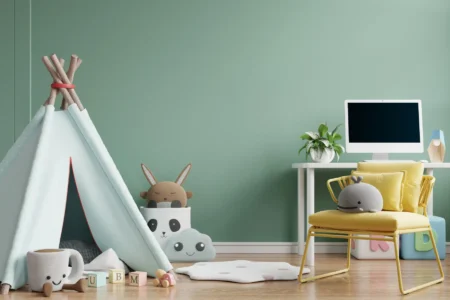 A child’s room isn’t just a place to sleep. It’s where they play, grow, learn and spend hours touching every surface without thinking twice. Toys move from floor to mouth. Hands go from markers to snacks to furniture in seconds. And dust builds faster than anywhere else in the house because kids never stop moving things around.
A child’s room isn’t just a place to sleep. It’s where they play, grow, learn and spend hours touching every surface without thinking twice. Toys move from floor to mouth. Hands go from markers to snacks to furniture in seconds. And dust builds faster than anywhere else in the house because kids never stop moving things around.
So keeping their room clean isn’t about having a picture-perfect space. It’s about health, safety and a calm environment where your child can actually relax.
How Often You Really Need to Clean
Kids create messes constantly, but that doesn’t mean you need to deep-clean every day. It helps to split the routine into small, manageable steps that match how kids actually live. Daily tidying keeps chaos from taking over—picking up toys, putting laundry in a basket, shaking out crumbs from the bed. These little resets take minutes but make a huge difference.
The weekly clean is where the real work happens. Dusting shelves, changing bedding, wiping furniture, vacuuming corners where toys hide dust bunnies—this keeps the room healthy and fresh. Kids track in dirt without noticing it, so floors need regular attention. Once a month, you go deeper: under the bed, behind furniture, inside bins, under rugs. Those areas collect dust fast and can trigger allergies if ignored.
Why Safety Matters When Choosing Cleaning Products
Children breathe closer to surfaces, touch everything and absorb chemicals more easily than adults. That means the products you use in their room matter. You want something that cleans well without leaving behind harsh fumes or residues that irritate skin or lungs.
Safe cleaning doesn’t mean weak cleaning. It means choosing ingredients that don’t harm. Look for simple, straightforward formulas that rely on things like plant-based surfactants, mild soaps or diluted vinegar solutions. Avoid strong bleach, heavy fragrances and anything that stings your eyes the moment you open it. If a product feels too intense for you, it’s definitely too intense for a kid’s room.
What Actually Works Without Being Harsh
Mild cleaners can still do a great job. A solution of warm water and gentle soap works for most surfaces—desks, shelves, plastic toys, high-touch areas. Microfiber cloths grab dust better than regular rags without needing chemicals. For floors, a gentle, non-toxic floor cleaner or diluted vinegar mix keeps things clean without strong smells.
For toys that get mouth time, warm water and a bit of dish soap is enough. Soft toys can go in the washing machine on a delicate cycle. Hard toys can soak for a few minutes and air-dry. You don’t need special sprays for everything—simple often works better.
Keeping the Air Clean Too
A kid’s room collects invisible stuff—dust, skin flakes, tiny fabric particles, bits from toys and art supplies. Good airflow matters. Skipping this step makes the room feel stuffy and can trigger allergies.
Open windows when weather allows. Shake out curtains or wash them occasionally. Vacuum not just the floor but the mattress and fabric surfaces. These small habits make the room healthier without extra effort.
Teaching Kids to Help (Without Stress)
Cleaning shouldn’t feel like punishment. Kids learn routines by doing, not by lectures. Start with simple tasks they can handle—putting toys in bins, placing books back on shelves, tossing laundry in a basket. When kids take small roles, the room stays cleaner naturally, and they build habits that last.
The goal isn’t perfection. It’s teamwork. When cleaning feels like something you do together, the mess becomes manageable instead of overwhelming.
Creating a Space That Supports Your Child
A clean room isn’t about controlling mess. It’s about creating a space where your child feels safe, comfortable and able to play freely. When the room is tidy and fresh, children sleep better, focus better and feel calmer. The environment affects their mood more than adults often realize.
Cleaning regularly with gentle, safe products keeps the space healthy without exposing them to unnecessary chemicals. And when you follow a routine that fits real life—not an unrealistic standard—you keep the room under control without burning yourself out.
A well-kept kid’s room isn’t about impressing anyone. It’s about giving your child a place where they can grow with comfort, freedom and a little more peace every day.
Picture Credit: Freepik



